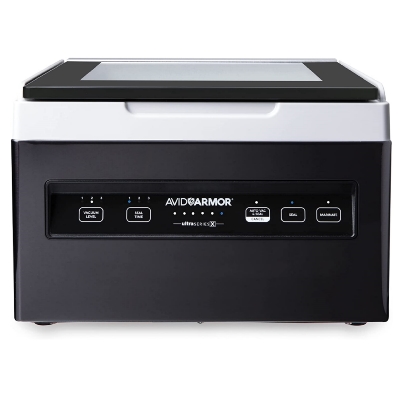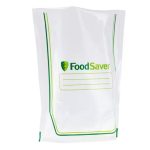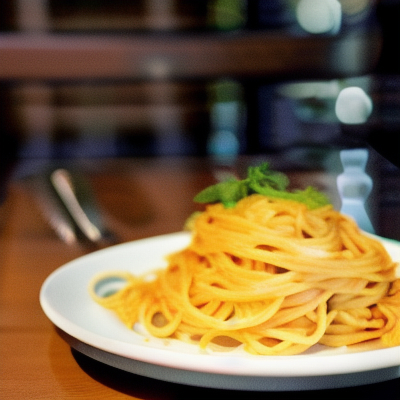
Buying a vacuum sealer is a great step to take if you’re looking to save on food costs and reduce waste and extend the shelf life of your food. But it can be a bit confusing with so many models and options out there. The two main types you’ll come across on the market, especially aimed at home users, are chamber and external vacuum sealers also known as suction vacuum sealers. But what’s the difference? Let’s find out.
What Are They?
Before we dive into the differences, let’s talk about what these machines do. Both types of vacuum sealers are designed to remove air from plastic bags filled with suitable ingredients. This keeps your food fresh for longer by slowing down the process of oxidation and by preventing bacterial growth, ultimately preserving the taste, texture, and nutritional value of the food.
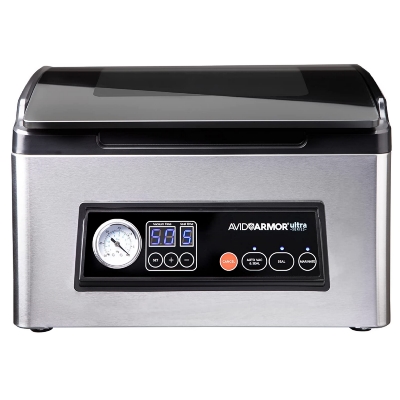
Chamber Vacuum Sealers
Chamber vacuum sealers are the bigger and more professional of the two. They have a large chamber where you put your bag of food. The chamber sucks out all the air and then seals the bag. The whole process happens inside the machine. They are great at sealing foods with liquids.
What You Need to Know About Chamber Vacuum Sealers
- Chamber vacuum sealers are especially good at sealing foods with high moisture content or liquids due to the air pressure reduction inside the chamber.
- Many models allow for customization of vacuum strength and sealing processes, which is ideal for sealing delicate items without damage.
- Chamber vacuum sealers are more expensive than external vacuum sealers, which might not be suitable for those with a limited budget. However, although the initial investment is higher than the external type, the use of cheaper bags compared to external vacuum sealers can offset the costs over time. Chamber vacuum sealers use smoother, often cheaper bags compared to the textured bags required for external vacuum sealers such as FoodSaver.
- These sealers are commonly used in restaurants, commercial kitchens, and butcher shops because of their speed and efficiency. But they can be suitable for people that need to seal large quantities of food regularly.
- They are generally larger and heavier than external vacuum sealers, which might be impractical for small kitchens but there are smaller, more affordable chamber vacuum sealers designed for home users and small businesses that offer many of the advantages of the larger models. We recommend you to check Wevac C12, it is a very compact model.
- Due to their size and weight, they are not easily portable and generally require a dedicated space.
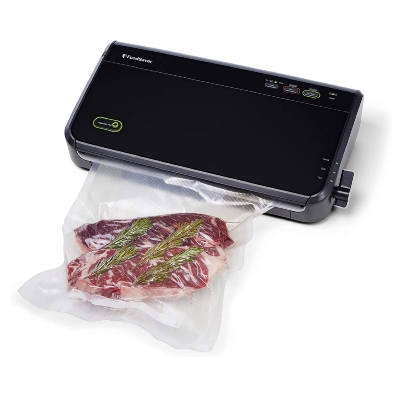
External Vacuum Sealers
External vacuum sealers are smaller and more compact. They are also usually more affordable. Instead of a big chamber, they have a sealing bar. You place the open end of your bag on the sealing bar, and the machine sucks the air out. Then it seals the bag using heat.
What You Need to Know About External Vacuum Sealers
- External vacuum sealers are generally smaller and more lightweight than chamber vacuum sealers, making them easy to move and store.
- They are typically cheaper than chamber vacuum sealers, making them a popular choice for home users and small businesses with a limited budget.
- External vacuum sealers are often easier to use with simpler controls, you don’t need to have experience with vacuum sealing. You can simply get one of the popular models like FoodSaver FM2000 or FM2100 and start sealing your food. They are also faster for sealing a fewl bags, as you don’t need to wait for an entire chamber to be vacuumed like with the chamber models.
- They are not as efficient in sealing foods with liquids or high moisture content compared to chamber vacuum sealers, as liquids can be sucked out during vacuuming and prevent a proper seal.
- External vacuum sealers require special textured bags to function properly, which can be more expensive than the smooth bags used by chamber vacuum sealers.
- They are ideal for people or small businesses that do not need to vacuum seal large volumes of food regularly.
- Because you can stop the vacuum process manually and see the ingredients as during the process, it’s somewhat easier to seal delicate items without crushing them. However there are chamber vacuum sealers with customizable settings that can do this more precisely.
- They generally require no maintenance as they have fewer components and a simpler design.
Comparing The Two
Now, let’s see how these two types of machines compare.
Size and Space
- Chamber vacuum sealers are quite large. They need a lot of space on your countertop. So, they’re not the best choice if you have a small kitchen.
- External vacuum sealers are much smaller and more portable. They can easily fit on a kitchen counter or inside a cabinet.
Handling of Liquids and Type of Bags
- Chamber vacuum sealers can handle various bag types, including thicker bags. They can also seal liquid-rich foods without a problem. In fact, you can even vacuum seal food like soup with a chamber vacuum sealer.
- External vacuum sealers can only work with specific bags. They also have trouble with liquids. So, they’re better suited for dry or solid foods. If you want to vacuum seal your liquid-rich food you have to freeze it first.
Price
- Chamber vacuum sealers are more expensive. But they offer more features and flexibility. There are models that are capable of vacuum sealing very large-sized bags.
- External vacuum sealers are cheaper. They’re a good budget-friendly option if you don’t need a lot of features. Typically, they are quite suitable for home users who won’t use their machine for vacuum sealing foods rich in liquids.
Usage and Speed
- Chamber vacuum sealers are perfect for heavy-duty usage. If you plan to vacuum seal a lot, this could be your go-to machine. Most machines do not need a cooldown period between seals.
- External vacuum sealers are great for light to moderate usage. If you only vacuum seal from time to time, this machine will be enough. Most models will require a 20 second cooldown between the consecutive seals.
Which One is Better for You?
So, which one should you choose? It really depends on your needs.
Chamber vacuum sealers are great for businesses, like restaurants or food storage facilities, or home cooks who vacuum seal a lot. They’re also the better choice if you want to seal foods with liquids.
On the other hand, external vacuum sealers are perfect for occasional users and those on a budget. They’re also great for small kitchens where space is a big concern.
